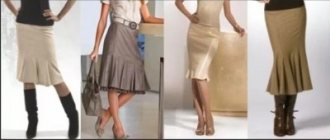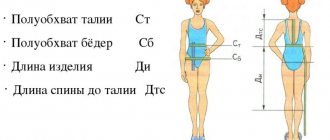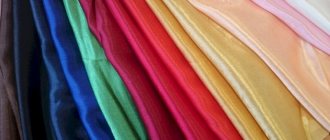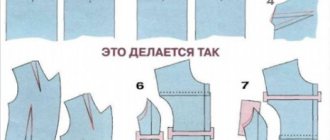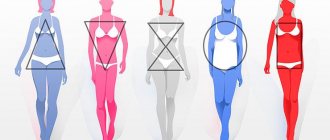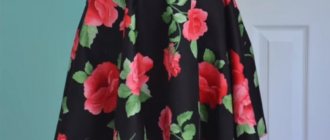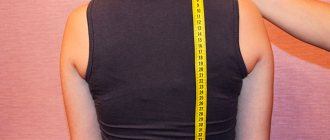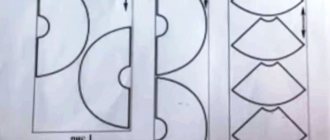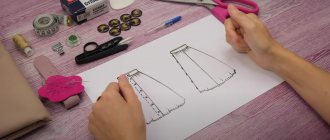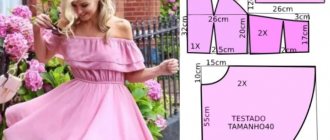Initial stage: taking measurements
To model a straight skirt pattern, the first step is to take measurements. Without obtaining the necessary parameters, designing will simply not be possible. In total, you need to know several values:
- waist circumference This parameter is divided by 2;
- hip volume. Measured at the most convex points and also divided in half;
- seat height. This is the distance from the waist to the hips;
- back length to waist line;
- total length of the finished product.
It is extremely important that all measurements are made strictly according to the rules. Otherwise, the result may not be accurate.
Waist
This measure is considered one of the most important. If you take the measurements incorrectly, a straight skirt will most likely simply not fit. The centimeter should be carried out strictly along the narrowest zone. It should be applied tightly to the body, but not pulled.
It is also worth considering that when taking measurements, the girl must take off her tights. This is due to the fact that they have a tightening effect and the result will seem several centimeters smaller than in reality.
Hip volume
In this case, the measuring tape is laid along the most prominent points. If a girl experiences the so-called “breeches effect,” measurements should also be taken. In this case, the centimeter is laid along the most protruding areas. If the difference between the resulting options is significant, the larger value should be taken into account.
Side seam and product silhouette
The next stage is silhouette modeling. First, the seam is lined up on the side. It is necessary to divide the segments T3-B2 and T4-B2 in two, and mark points T31 and T41 on the resulting middle. Perpendiculars T32 and T42 are drawn from them - half a centimeter each. To make the waist line even, you need to lengthen the seam values on the panels by half a centimeter. To do this, temporary points T3x and T4x are placed, T3-B2 and T4-B2 are extended upward.
The outline of the bottom edge in the classic model may be different. Therefore, the seams on the sides are narrowed or widened along the edges. If you like strict skirts, you need to make a narrowing - set aside one and a half centimeters from the H2 point on the sides (you will get marks H3 and H4).
To construct a line on the side seam, segments are drawn through T3x, T32, B2, H3 and T4x, T42, B2, H4. You need to draw them smoothly, so it’s more convenient to use tailor’s patterns.
burdastyle.ru
Calculation of matter
It is not only the construction of the straight skirt pattern that deserves attention, but also the calculation of the fabric. If you approach it responsibly, you will be able to significantly save material and avoid unnecessary expenses.
The main parameter that is taken into account when performing such manipulations is the width of the product. Accordingly, the circumference of the hips is taken into account. If this parameter is at least ten centimeters less than the width of the canvas, the consumption is one length with an increase of about twenty centimeters. Half of this allowance will be used to hem the hem, and the other half is needed for the waistband.
For a classic skirt with pleats, the calculation is made taking into account their number. If the model implies the presence of a circular fold, three lengths are taken. A small allowance is also added for hemming.
Constructing a straight skirt pattern
And although we have a magical generator on our website for constructing a pattern for the base of a skirt, I hope my method will be useful to you.
Next, you can modify and model the skirt to your liking, based on my lessons, for example this one. So what do we need.
- Fabric selection
It is better to choose the fabric for the costume group. With a high content of natural fibers (wool, silk, cotton) With the addition of synthetics, I wouldn’t get carried away with elastane. Fabrics with elastane shrink more.
- Determining the amount of fabric
If the hip volume is up to 100-110 cm, then the fabric for the skirt needs Skirt length + hem (4-6 cm) + fabric shrinkage 10-15%
- Choice of lining and accessories
The lining fabric is usually taken in the same amount as the main fabric. Zipper braid 20-25 cm, hook or button, threads to match the fabric, threads to match the lining, interlining for the belt and vent, preferably on a fabric basis.
Self-drawing technology
A straight skirt pattern will allow you to create a truly unique item that will fit perfectly on your figure. After all, when sewing products that are sold in stores, a standard pattern is used. It is not possible to take into account the individual characteristics of a woman’s silhouette. If you figure out how to make a skirt pattern, the outfit will fit perfectly.
To perform such manipulations you will need:
- graph paper;
- eraser;
- well sharpened pencil;
- calculator for making calculations;
- ruler.
Once everything you need is at hand, you can begin building the skirt, and then sew according to the received drawing.
Meshing Rules
The basis of the pattern is created by initially constructing a grid consisting of three horizontal and five vertical lines. With their help, the dimensions of the main parts of the structure are determined. In fact, this is the space with which a number of manipulations will need to be carried out in the future.
The width of the mesh is the volume of the hips with an allowance to ensure a loose fit. It is only a couple of centimeters. The length corresponds to the length of the future product with an increase for tucking and decorating the belt.
Once the main indicators have been determined, design can begin. This process is carried out in several stages:
- Initially, the waist line is indicated by drawing a horizontal line. Its width corresponds to the width of the grid itself.
- After this, a vertical straight line is drawn downwards from the left point of the drawn line. This way the center of the back half is determined, equal to the length of the drawn mesh.
- Now you can start building the front. It is also equal to the length of the mesh. To perform these steps, draw a vertical line down from the right edge of the waistline.
- At the next stage, a horizontal straight line is made, indicating the bottom of the product. This line connects the points of previously drawn vertical lines.
- After this, you should draw a straight line for the hips. It is placed from the waist at a distance equal to the length of the back.
All that remains is to divide the hip line in half by placing a dot in the center and drawing an auxiliary line in the area of the side cut. It should be vertical and perfectly straight.
At this stage, the pattern base is already ready. You can now start marking the darts. This process is also not difficult if you strictly follow the instructions. In fact, a skirt without darts can also be created. True, in such a situation it is unlikely to be possible to ensure a perfect fit.
Darts
It is extremely important to correctly mark the darts on the skirt. Even minor errors will lead to the fact that the sewn clothes will not fit as tightly as required by the cutting rules. Therefore, the calculation process in this case should be carried out with special care.
When creating a model with two darts at the back, you need to follow the following instructions:
- The first step is to determine the total solution of these elements. To determine it, subtract the waist circumference from the mesh width.
- At the next stage, the dart parameter along the side line is determined. It is equal to half of the resulting total solution.
- Now you need to find out the solution for the future dart on the back of the product. To obtain it, you need to divide the total solution by four and add one centimeter to this value.
- The front dart opening is determined using the same scheme, but in this case a centimeter is not added, but subtracted.
It must be taken into account that the construction of the skirt pattern and the designation of darts are carried out without taking into account the allowances that are necessary to ensure a loose fit along the waist line. Otherwise, the product in the waist area will not fit tightly enough. Accordingly, the clothes will be visually large. It is possible that this will create the impression that the cutting was done incorrectly.
Back half
The pattern for the base of the skirt involves marking the darts in the back. For this purpose, a distance corresponding to the waist circumference divided by 4 is measured from the center of the hip line. The middle line of the dart is drawn from the marked point. It is indicated by a dotted line. From this strip it is necessary to mark half of the solution in both directions. The centers of this dart should be located exactly three centimeters above the contour of the reed. From the designated points, inclined lines are drawn.
Now you need to deal with the side cuts. To designate them, half of the solution should be set aside along the waist from the auxiliary straight line. A convex curve is drawn from the marked point to the center of the hips.
Half of the defined extension should also be set aside from the side line along the bottom. A straight line is drawn from this point to the center of the thigh.
The side cut should extend one centimeter beyond the waist. At this point on the pattern, a mark is made, which, by making a concave curve, is connected to the upper right point of the dart.
After performing such manipulations, the bottom is drawn. For this purpose, the side cut is shortened by literally five millimeters and a convex curve is made to the bottom of the center of the rear half of the product.
Front half
Separately, it’s worth figuring out how to build a front pattern. Initially, a notch should be drawn on it. For this purpose, a distance is measured from the center along the hips, which is equal to a quarter of the waist circumference. From this point the middle line of the notch is made. Just like in the case of the pattern for the back half, it is made dotted and led strictly upward vertically.
From the marked dotted line along the waist, segments are drawn that correspond to half the solution. The center of the dart is located three centimeters higher than the hips.
Now you need to mark the outline of the side cut on the pattern. For this purpose, half of the solution is deposited from the auxiliary straight line to the right along the waist. A point is placed at this place, which is connected to the center of the hips by making a convex curve.
To the left of the auxiliary line, half of the defined extension should be measured, and the resulting point should then be connected to the center of the straight line on the hips. The cut is made exactly one centimeter longer than the mesh. This point is combined with the upper left point of the dart strictly along the waist line. For this purpose, it is also necessary to draw a concave curve on the pattern.
To make the skirt pattern complete, all that remains is to draw the bottom. To do this, the side cut is equalized in length with the back part. The center line of the front part is extended by only a centimeter. In this case, the point is aligned with the alignment point of the side seam by making a convex curve.
Belt
The design of a straight skirt often implies the presence of a belt. There are also models where this detail is not provided. If a belt is needed, this part must be cut out. It can be with or without overlap.
The option without overlap implies the presence of short transverse sides that come close to each other, but without overlapping one another. This type of belt is used if clothes will be fastened with a zipper or hooks. The zipper can be placed on the back, side or front.
When choosing a hook-and-eye fastener, the belt is a long rectangular element folded in half lengthwise. The width of this part in this case is chosen based on personal preferences and varies, as a rule, within 2 - 5 centimeters. The length of the belt should be equal to the top of the base. To this value it is necessary to additionally add allowances equal to one and a half centimeters.
If you select a part with an overlap, one of its edges will overlap the second. The allowance for decorating the fastener is 3 cm. The shape of the edge may be different. For example, with corners, rounded or rectangular.
Instead of a belt, you can use an elastic band. In this case, no fittings are required at all. The model does not imply the presence of zippers, hooks and buttons.
Cutting details
To sew a product, several parts are cut out. You will need one front element that bends in the center. A couple of parts for the rear are also being made. Additionally, a belt can be cut. Often the presence of a lining is also implied. To create it, a special lining material is used.
This creates the base of the skirt. If desired, it can be modified somewhat. For example, correct the lower part. In this way, a model expanded to the bottom will be obtained. If you remove the darts at the front, you get a skirt with two notches located only at the back. In both the first and second cases, the outfit will change significantly and look completely different.
Model history
Straight-cut skirts are an achievement of progress and the sociocultural revolution of the 20th century, which opened up many opportunities for women. Its dynamic silhouette, clear, geometric lines, conciseness, “dear simplicity” - all this skirts owe their roots in classical fashion. The fundamental foundations of the model were laid about two centuries ago, when fashion designers turned to the lines of antique outfits. In our familiar form, straight varieties of “bottom” appeared in 1900.
woomen.me
Around 1910, the French tailor and couturier Paul Poirier came up with a skirt that tapered at the ankles, but it restricted movement and was uncomfortable. Ten years later, the famous “women’s liberators” - Mademoiselle Chanel and Jeanne Lanvin - made the skirt comfortable. For the first time, they proposed making the style even, which coincided with the fashion of the 20s for boyish outfits and an active lifestyle. For the first time, the length of the garment rose to knee length rather than ankle length, creating the skirt look we are familiar with today.
Throughout the 20th and early 21st centuries, the length and fit of the model changed. Skirt ends ranged from an elegant mid-calf cut in the '50s to the popular millennial cut at or just above the knee today. The traditional length of a thing is between these positions. A skirt that covers the knees, but does not reach the fullest part of the calf, is a universal item that can balance the figure and always remain relevant.
shoppingmall.com.ua
Cutting technology
After constructing a drawing of the future product, it is extremely important to make the cutting correctly. For this purpose, it is necessary to familiarize yourself with all the intricacies of transferring the diagram onto the canvas. Initially, you need to determine the back and front sides of the material. All marks are made on the wrong side. The fabric is laid out taking into account the direction of the grain fibers and the features of the print.
It is recommended to iron the material before transferring the drawing. Thanks to this, all manipulations will be much easier.
It is best to work with materials that do not crumble. For example, novice craftswomen can use chintz. To cut a straight skirt, you must follow these instructions:
- The matter along the lobar fibers is folded in half.
- Pre-cut paper parts are laid out on it. They are fixed to the canvas with pins.
- Initially, the details of the future product are outlined strictly along the contour with soap or small pieces.
- Then they are outlined with seam allowances equal to 1 - 2 centimeters.
- The matter is cut along the second of these contours.
- Pins and paper parts are removed from the canvas.
If the fabric has stripes, geometric patterns or some other prints, it is necessary to place the drawing on the fabric so that the lower sections are directed in one direction. It is extremely important that the pattern on the seams matches perfectly. If it is excessively large, it is recommended to place it in the most visible area. Beginner needlewomen, however, are better off using plain fabric. In this case, the risk of making a mistake is reduced to a minimum. Printed products should be chosen after you have gained experience.
Stitching parts
Before stitching the main structural elements, it is necessary to process all edges. It is most convenient to use an overlocker for this purpose. It is also possible to use a machine zigzag stitch. Even if the fabric is not prone to fraying, it is not recommended to sew it immediately.
Before joining the parts on a sewing machine, they must be stitched together by making a basting seam. For this purpose, the blanks are folded with their front sides facing each other, aligning the edges as accurately as possible. After this, they begin to sew them together by hand. The sequence of actions in this case will be as follows:
- The undercuts are sewn first. The stitches are made from the narrow end upward.
- Then folds, cuts and other elements are outlined.
- The side seams are basted. It is extremely important that all lines are aligned. The stitching goes from the front side from top to bottom.
- The bottom and top edges are folded and also basted.
When making a basting seam, it is recommended to make stitches no more than five millimeters. Otherwise, they will diverge when trying on. Naturally, it will be quite difficult to make a full correction and eliminate shortcomings in such a situation.
How to accurately calculate dart sizes
In the example above, the size of the darts is calculated using a template - front 3, back 5, but there is a way that allows you to find out the size of the darts with 100% accuracy for any parameters.
So, here it is, this universal formula. You need to subtract the waist circumference from the hip circumference. In our example: POB 46 - POT 33 = 13 cm.
Then, based on the results obtained, the darts are calculated.
- Side dart - divide the result by 2 : this is 13/2 = 6.5 cm,
- Back dart - divide the result by 3 : this is 13/3 = 4.3 cm,
- Front dart - divide the result by 6 : this is 13/6 = 2.17.
Product fit
Before sewing all the parts together with machine stitching, you need to try on the assembled product. This way it can be perfectly tailored to your silhouette. Many beginning needlewomen consider this stage unimportant and therefore neglect it. In fact, this step is of particular importance and should not be skipped.
The adjustment is carried out according to the following scheme:
- The skirt does not turn inside out and is put on. In this case, the fastener breaks off.
- The side seams are in the correct position.
- If the width is excessively large, the excess is immediately removed.
- If there is insufficient volume, the seam is ripped out and swept away again, taking into account the necessary adjustments.
- The size and location of the recesses are viewed. If mistakes were made during their creation, they must be ripped apart and re-laid.
All changes are initially made on the right side of the garment, and after that they are transferred to the left. If the correction was significant, the fitting must be done again.
Final assembly
Having corrected all the shortcomings, you can safely begin machine stitching. In this case, it is extremely important to select threads of a suitable shade and set the optimal stitch length on the sewing machine. When stitching, it is recommended to position the front piece over the back half.
The product is assembled according to the following scheme:
- The machine stitch is laid a millimeter from the basting and moves closer to the cut.
- The first step is to sew the central seam along the back of the product, if provided. At the same stage, if necessary, a cut is formed and a zipper is sewn in.
- After this, all the darts are sewn in.
- When the notches are formed, you can join the side seams. They are stitched, as with basting, from top to bottom.
- A belt is sewn to the base. If it is not provided, the edge is processed for subsequent stretching of the elastic.
- After this, the bottom of the skirt is hemmed.
Experienced needlewomen recommend ironing each stitched seam immediately. Due to this, further work is significantly simplified.
Even a novice needlewoman can independently create a drawing and sew a straight-cut skirt. To do this, just study the described instructions and strictly adhere to them. Thanks to this, you will be able to achieve excellent results and please yourself with an incredibly beautiful new thing.
FAQ
Is the increase in looseness of fit indicated by OT or OB?
It is necessary to indicate the increase in freedom of fit according to OB. (The OT-1cm increase is included in the cutting method and is provided for in the program)
On the pattern on the back panel there are already 4 darts. Is this technology for the best fit?
An additional dart is needed when the total opening of the darts is large (or, in other words, when there is a large difference between the hip circumference and the waist circumference) and serves to ensure the best fit. An additional tuck should be built if the total opening of the tucks exceeds 12-13 cm. This point is described in the attached methodology.
